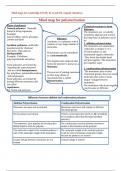Summary
Summary Mind maps for polymerisation for Cambridge IGCSE and O/L students
- Course
- Chemistry
- Institution
- 11th Grade
The Mind maps provide the concise summary of 1. concept of polymers 2. addition polymers 3. condensation polymers 4. pollution of synthetic pollution and solutions.
[Show more]



